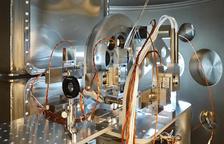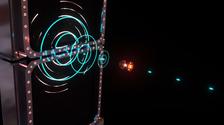View into the interaction chamber with the revolver for up to six diamond anvil cells in the centre. (Credit: DESY, Cornelius Strohm)
The European XFEL X-ray laser opens up new perspectives for high-pressure research: An international team of researchers, also from DESY, used the intense laser flashes to heat and analyse samples in so-called diamond anvil cells at the X-ray laser for the first time. The experiments clearly exceeded the scientists' expectations, as the 50-strong team of experimentalists led by Stewart McWilliams from the University of Edinburgh reported after the completion of the experiments.
Diamond anvil cells (DAC) belong to the standard instruments used by high-pressure researchers. In them, two small and ultra-hard diamond anvils compress tiny samples, generating pressures such as those prevailing in the interior of the Earth. This way, geoscientists can simulate the conditions inside our planet and obtain important information about the Earth's core and mantle. “So far, we have used diamond anvil cells on storage rings such as PETRA III only,” explains DESY mineralogist Hanns-Peter Liermann. “Until recently, we never held them into the much stronger beam of a free-electron laser; we didn't even know whether it would work at all.”
At the High Energy Density (HED) instrument of the European XFEL, the researchers now put a new interaction chamber into operation for the first time, which is specially designed for experiments with diamond anvil cells at the X-ray laser. “Currently only European XFEL can deliver hard X-rays with an energy that is high enough to easily penetrate the diamond anvils” says Ulf Zastrau, the group leader of HED. The vacuum chamber features a revolver, holding up to 6 DACs for quick exchange and optimised use of the beam time, two large area detectors for recording the diffraction patterns as well as an optical system for imaging the samples and non-contact (pyrometric) temperature measurement.
The complex setup was developed by DESY as part of the consortium Helmholtz International Beamline for Extreme Fields (HIBEF), in which a number of institutes under the leadership of the Helmholtz-Zentrum Dresden-Rossendorf (HZDR) have joined forces to carry out experiments under extreme conditions that are only possible in this form with the expertise of the partners and the beam properties of the European XFEL.
Among other things, the experiments benefit from the fast pulse rate of the European X-ray laser, which can generate up to 27,000 flashes per second. While a first X-ray flash heats and melts the sample compressed in the cell, the subsequent flash allows the changes in the sample to be measured precisely – even before the sample can react with the cell. “This is only possible at the European XFEL,” says Cornelius Strohm, who heads the HIBEF group at DESY. “Only the European XFEL provides a sufficient number of X-ray flashes of high energy in short succession.” The high photon energy provides scientists with more detail for a better structural analysis of their samples.
In the first experiments with DACs at the European XFEL, the team initially focused on systematic investigations as a basis for future experiments. For example, the researchers tested whether the diamond anvil cells can withstand multiple exposures with the intense X-ray pulses of the European XFEL, whether and how the sample can be heated by a first X-ray pulse and then examined with a further pulse immediately afterwards, how the observed temperature depends on the time interval between the pulses, and whether the intense X-ray flashes trigger chemical reactions between the sample and the pressure transfer medium or the diamonds.
While the researchers are only at the beginning of a detailed evaluation of the extensive data, they can already report on initial observations: DACs with pressures of up to one million atmospheres do indeed withstand multiple exposures with the beam of the European XFEL. Suitable samples could be strongly heated by the X-ray beam and, in some cases, melted. Last but not least, chemical reactions and phase transformations within samples were induced and observed by the X-ray beam. Proposals for further experiments have already been submitted in order to explore the full potential of the research possibilities with diamond anvil cells at the European XFEL.
(from DESY News)
Further reading: HIBEF homepage








